skip to main |
skip to sidebar
“Never bend your head. Always hold it high. Look the world straight in the eye.”
~ Helen Keller

Straight in the eye
Camera: Canon PowerShot A710 IS
Date & Time: July 27, 2008 at 11.23am EEST
Location: Joensuu, Finland
Exposure: 0.017 sec (1/60)
Aperture: f/3.5
Focal Length: 5.8 mm
Modifications: cropping, adjusted brightness, contrast & color levels, noise reduction
Among the rules of animal and people photography is to focus on the eyes. It's a rule that I never questioned. I don't know about you, but I would definitely hate it if someone would take a photo of me and the camera is focused on the strands of gray hair on the crown of my head. Other than the fact that it would expose the ugly side of me, I am quite sure that no one would find it interesting.
According to Frank H. Philips: "On many bugs the eyes (and even bug “pupils”) lend a dramatic connection between them".. Hence photos focused on the bugs' eyes look very interesting. Since the day I read Frank Philips' tip, I have always aimed for the insects' or spiders' eyes. It is not easy, but eventually, you will get the hang of it. You just have to keep on practicing.
The major challenge in insect macrophotography is of course the size of the insects. To avoid immediate disappointment, look for bigger insects to practice on. Rhinoceros Beetles have big eyes and they are rather calm which means that you can take a hundred of photos of it if you want to. But those huge beetles are quite rare. Lady bugs and shield bugs are tiny but quite easy to photograph. Once you have spotted those critters, take as many photos as you can from different angles. Head-on perspective is my favorite. It is very challenging but I find it really cool, a hundred times more intersecting than a boring aerial view like this pic. Insects are beautiful and when photographed the right way, I think a lot of people would appreciate them more. I am quite pleased with the comments I got when I uploaded these pics:

1. in your face!
2. Fly
3. I dare you to move
4. face to face
To be fair with the bugs, I took a photo of my eye:

Vision of a sunset
Camera: Canon PowerShot A710 IS
Exposure: 0.017 sec (1/60)
Aperture: f/2.8
Focal Length: 5.8 mm
To view the large size click here
If you have the right equipment for macrophography then good for you. Your photos shouldn't suck, if they do, hmm shame on your gears :-) But if you are a P&S user like me, never ever focus on the limitations of your camera. The key is to get very close to the subject. Concentrate your efforts on following the basic principles of photography and you will never go wrong.
“The policy of being too cautious is the greatest risk of all.”
~ Jawaharlal Nehru Stalked!Camera: Canon Powershot A710IS
Stalked!Camera: Canon Powershot A710IS
Location:Punkaharju, Finland
Date & time: 5.36pm EEST
Exposure: 0.017 sec
Aperture: f/2.8
Focal length: 5.8mm
Modifications: cropping, adjusted brightness & contrast levels
I am keen on learning more about insect photography. I always read tips from some forums and blogs of professional photographers. Sometimes reading about some so-called tips make me wince. I was shocked to find out that some photographers resort to freezing bugs so that they could get 'better' photos of them. I think that is very wrong to sacrifice a bug's precious life for the sake of art. Talk about some human's selfish needs. No wonder so many species are now extinct. In my opinion such form short cutting defeats the real purpose of nature photography. There's nothing like capturing nature's priceless moments.
In case you find nature macrophotography very interesting, then by all means give it a shot. It's not exclusive to people with high-end cameras, if it was then I would not have the thousands of bugs and flower close-ups that are in my hard disk right now. I already have an entry about flower macros. For now I want to share with you how to find and stalk bugs in their natural environment.
One thing that you should do as you walk close to the subject is to adjust your camera settings. Lower the exposure if the light is too harsh. Do you think you need to change the white balance? Do all the necessary adjustments prior to getting up close to the bug.
Spiders
It's quite easy to find spiders. If not in their web, they are usually on leaves or crawling on the ground. These 8-legged creatures are not insects. They don't have wings, but once they sense your presence they will disappear in flash. Why? Because most of them have 8 eyes that's why they can easily detect human presence. Getting good photos of them is a bit difficult, but not impossible. Just don't do anything that will startle them, move very slow but press that shutter like a maniac. If you are very close, make sure that your camera won't accidentally hit the leaf or whatever the spider is on because it's going to blow your chance to take more photos. In a blink of an eye spidey will be somewhere else. Here are two spiders who didn't mind me taking photos of them:
1. Greenie
2. Spider on a stinging nettle
Bumble bees
These ever buzzing winged insects are very restless especially if they are surrounded by plenty of tiny flowers. A bumble bee will just stay on a flower for a few seconds. They are normally too busy to get intimidated by the camera, but you have to press on the shutter as fast as you can. I haven't had the luxury of time to use manual focus on bumble bees. My camera is always on full auto mode whenever I take photos of them. My best shots bumble bees:
1. Coming out of the shell
2. Another day in the office
Honey bees
If bumble bees are always in a hurry to get things done, honey bees are different. They are quite methodical. Hence, easier to photograph. You can follow it's movement from one flower to another and you can take many shots of it because it stays on a spot for a minute or more.
1. And yet another hard worker
2. Behind bars
Hover flies
I have plenty of hover fly photos in my gallery. Based on my experience, they are the easiest winged creatures to take photos of. You can find them on flowers and sometimes they rest on leaves or blades of grass. You can be just inches away from them but they would not care, except if you will shake the leaf or flower. Once you are used to taking photos of bumble bees & honey bees, then you can effortlessly photograph hover flies. You an experiment on many different angles. Hover flies are twice smaller than bumble bees, to capture more of its detail you have to be really close to them.
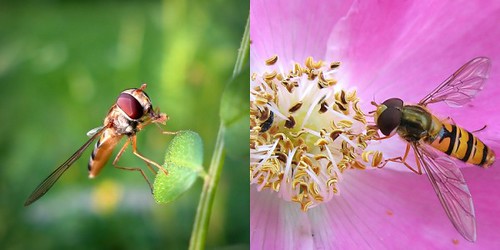
1. A praying hoverfly?
2. in the middle of something
Butterflies
These lovely creatures are probably everyone's favorite insect. Photographing them is quite challenging. Once you see one on a flower, approach it slowly. Your mere shadow will ruin your chance to take photos of these winged insects. So try your best not to cast your shadow over it. If you startled accidentally, it will fly away. But don't fret, because it will come back to the same spot where you saw it. I've seen it happen several times. Like when I took these photos:

1. A summer remembrance
2. Monday blues
The first time I saw a huge moth was when I was 5 years old. It was orange with beautiful patterns on its wings. The wing span of that moth as about 18-20 centimeters. It was my mom who saw it first. Until now I remember how that moth looked like. Sadly, it was the first and last time that I saw such a beautiful live moth. I saw something that looked almost like it but it was in a butterfly museum in Asia, pinned on a wall. I probably would never see anything like that in this lifetime. So while some species are still alive, let's not waste the opportunity. Photograph them while you can. A few decades from today they may no longer be around, but if you took the risk of getting up close to those critters then you will have beautiful pictures to show to your grandchildren someday.
“All nature's creatures join to express nature's purpose. Somewhere in their mounting and mating, rutting and butting is the very secret of nature itself.”~ Graham Swift
 Make love, not war
Make love, not war
Location: Pähkinärinne, Vantaa. Southern Finland
Date & Time: June 28, 2008 4.09PM EET
Camera: Canon PowerShot A710IS
Exposure: 0.008 sec
Aperture: f/4
Focal length: 5.8mm
Among the advantages of a compact camera is that its size and weight won't interfere that much with your daily routine. Take the photo above as an example. I took that on the way home from the grocery and I had two shopping bags at the time. I can't imagine taking photos of bugs by the road side with a heavy DSLR while carrying bags of groceries I am not strong enough to do that.
It's so easy to take photos of insects while they are mating. You can take 100 photos of them is you are quick enough. But that will leave you with so much work afterwards. If you want to upload the photos later to your online gallery, it's a must to pick the best ones, otherwise the photo viewers may get bored to death except of course if they are entomologists who would like to carefully document the bugs' mating process. Once you see a mating pair, don't be afraid to get very close to them. Trust me, they would rarely mind your presence unless startle them by moving the leaves or petals where they are. But when do they mate? The earliest time of the day when I saw mating butterflies was at 11 AM. I once took photos of beetles mating at 7 PM, the evening light was nice then. Of course if there is a butterfly park near you, there would always be mating couples there. But if you are like me who don't have much choice but to look for them in the wild, you have to be alert. Once you see two of the same kind of butterfly, there's a big chance that they are in the middle of a courting ritual. Try not to disturb them and just walk closer to their direction when they get down to the actual business. Beetles are easier to capture because they don't move much. In addition to that, they mate for hours. You will have a lot of time to take photos them. When I was on vacation in the Philippines, I saw mating tortoise beetles while I was on my way to a nearby mall. I took photos of that couple and then after my 2-hour mall trip, they were still at it. Get the picture?
Presenting.. my porn collection:
1. Caught in the act, 2. Size doesn't matter?, 3. Afternoon delight, 4. bugs in love, 5. mating beetles, 6. mating butterflies
If you find those photos funny & interesting, why not give insect porn a try? Forget about giving those bugs some privacy, they do it by the road side for crying out loud. Just look for them and keep in mind that sex sells.
“Luck is what happens when preparation meets opportunity” ~Seneca
Hover fly in flight
Location: Filinvest Alabang, Muntinlupa Philippines
Date: January 1, 2008, 3:23 PM Manila time
Camera: Canon PowerShot A710 IS
Exposure: 0.017 sec
Aperture: 3.5
Modifications: Cropping, adjusted brightness, noise reduction
If you have visited my Flickr photostream, you may have noticed that usually my reply to comments is: "it's just a lucky shot" especially when it is about photos of insects in flight. I even referred to the photo above as 'my ultimate lucky shot', why? Because it really was. I took that photo while I was in the Philippines. It was the first day of the year and I was my nephew's baby sitter for the day. We were walking along Filinvest Avenue in Muntinlupa. Of course I was prepared to take photos. I hoped to find lady bugs, but I didn't find any. Then I noticed a bug in stationary flight! Oh joy, oh rapture! If I may borrow that line from Helga G. Pataki. I normally take more than 10 shots of my subjects but that time, I didn't have the chance to press the shutter more twice. Thanks to little Clarence John for scaring the bug with his hand. When I asked him why he scared it away, his response was: "it may bite me". A piece of advise: if you want to capture insects in flight, don't bring a kid along, it's for your own good. Fortunately one of the photos turned out okay and it's my most interesting photo to date.
Okay so I did it once, big deal, but can I manage a shot like that again? The geek in me analyzed the probability. Based on my experience, taking photos of bugs in the Philippines wasn't exactly a walk in the park. I think the warm climate is the culprit, it makes bugs hyperactive. The temperature during summer months here in Finland will never match the summers in the tropics. That means that insects here can't be as restless. In a addition to that, my nephew doesn't live here, so I though maybe I can capture bugs in flight again. It shouldn't be impossible. And besides taking photos of insects on flowers or leaves has become too easy for me. I wanted to challenge myself that's why not so long ago, I set a goal to capture bugs in flight, while they are around. I found out that it is not time-consuming because you will only have a few seconds to press the shutter. I considered that as a good thing because at least I was able to attend to other things in the backyard like weeding & watering the plants.
Here are some of my bugs in flight photos:

1. Ready or not, here I come!, 2. captured in flight, 3. Almost there, 4. Off to the next destination
"How did you do that?", some viewers asked. Well, I was prepared to capture those critters and grabbed the opportunity to fire a few shots at them while they were in midair. Based on Seneca's quote, I can consider it as luck. So if you want to take photos of flying insects, remember that you need patience, camera and luck :-)









